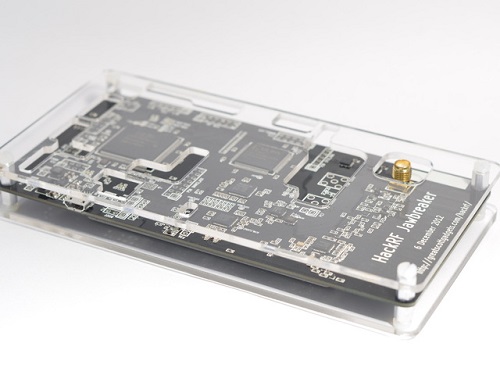HackRF is an open-source USB-powered software-defined radio (SDR) peripheral able to transmit or receive radio signals ranging from 30 to 6,000 MHz. The project aims to create a single software platform capable of implementing any wireless technology (Bluetooth, ZigBee, LTE, 4G, AM/FM radio, etc). Changing radio protocols and spectrums is as easy as reprogramming the device. In essence, SDR resembles the software-based industry-standard digital audio techniques; but digitizes radio waves rather than audio waveforms.

While primarily designed for use with a USB host-computer, HackRF can also be used for stand-alone applications when apired with Jared's HackRF PortalPack.
Thanks to Moore’s Law advancing processing power, SDR has brought versatility to the home computer. The enhanced processing power of modern computers has greatly matured to a point where it’s possible to capture incoming wavelengths and convert them to a desired protocol using software alone, unlike radio chips, which have to be hardwired for a single protocol.
The average mobile phone contains a different chip for latching on to 4G LTE, Wi-Fi, GPS, and Bluetooth ― you’re looking at a total of four to five chips per unit. The beauty of SDR is that it unifies these functions onto a signal chip by relying exclusively on software to initiate the specific application once the electromagnetic signal has been converted. SDR thus paves the way for new kinds of highly adaptive networks, unheard of with today’s fixed narrow-frequency-band radio transmission systems.
Deregulation
The same computational power proliferating SDR also provides flexible and low-cost tools available to a wider audience for the first time ever. Open-source SDR tools such as HackRF will push the boundaries of radio communication technology since users will have access to technology previously reserved only for research labs. SDR’s lack of confinement to anyone frequency makes it difficult for the Federal Communication Commission to continue its tight regulation of the electromagnetic spectrum, and as SDR standardizes; more users will find themselves experimenting with amateur radio.
HackRF’s wideband
HackRF’s maximum bandwidth is 20 MHz, equivalent to approximately 10 times the bandwidth of TV tuner dongles, a popular SDR application. It’s also worth mentioning that the 20 MHz bandwidth allows the HackRF to be used for high-speed digital radio applications such as LTE and 802.11g.
The transceiver
By default, HackRF can only transmit or receive radio signals because it operates in half-duplex mode. A second HackRF device is required to simultaneously send and receive signals using full-duplex operation.
Ease of access
HackRF is quite an inviting device; it’s small enough to fit into a laptop carrying case so you can carry it anywhere, and doesn’t require an external power source since it’s completely USB powered.
Assume you’re on vacation and there’s no 4G LTE service where you’re situated. Simply tune one HackRF to the available signal, and the other one to broadcast 4G LTE, and problem solved.
In its present beta incarnation, the HackRF unit supports Linux, OS X, and the Windows operating systems. Additionally, it’s USB 2.0 compatible and works with the GNU radio software framework. HackRF support can be added to other SDR software as needed. While there are 16 days left on the kickstarter campaign, HackRF has more than four times surpassed its desired goal.
Visit HackRF’s Kickstarter page for all the latest updates.
Advertisement
Learn more about Electronic Products Magazine





